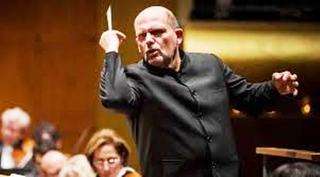|
Back
A Grand, Spatial Opening Night New York
David Geffen Hall, Lincoln Center
09/20/2018 -
Ashley Fure: Filament, for Trio, Orchestra and Moving Voices (World Premiere)
Maurice Ravel: Piano Concerto in G major
Igor Stravinsky: Le Sacre du printemps
Rebekah Heller (Bassoon), Nate Wooley (Trumpet), Brandon Lopez (Bass), Daniil Trifonov (Piano)
Constellation Chor (Moving Voices), Marisa Michelson (Director), New York Philharmonic Orchestra, Jaap van Zweden (Conductor and Music Director)
César Alvarez, Lilleth Glimcher (Movement and Visual Direction), Brandon Clifford, Wes McGee, Johanna Lobdell (Matter Design), Marika Kent (Lighting Design), Tolulope Aremu (Costume Design)

J. van Zweden
The words “Grand Opening” hardly described the assemblage of talents at last night’s first concert of the season. So much of an assemblage that one often couldn’t grasp it all.
Of course it was the initial “official” showing of the new Music Director, Jaap van Zweden, he whose face glowers out on posters throughout the city. (That is no indication of his personality or acumen, but friends in the East Village, ignorant of the Phil, are puzzled by the look.) It was a startlingly new sound for that most familiar personality here, Daniil Trifonov. And it was the world premiere of a composer whose musical participants were scattered from the topmost balcony throughout the audience up to the stage, with Marika Kent’s lighting design which highlighted them all.
And that was the first confusion. Not in a negative way at all. But so much was happening in Ashley Fure’s Filament for Trio, Orchestra and Moving Voices (New York Philharmonic Commission) that one hardly had time to hear the music.
Don’t misunderstand me. Within these 14 minutes, I knew that Ms. Fure was creating some marvelous sounds, and half of Filament were auditorially brilliant. Yet this was also a series of shows. A show of Constellation Chor, humming, shouting singing through black wide-ended megaphones. First their voices came from around David Geffen Hall. Then they descended, marching down the aisles like demons in a Hieronymus Bosch painting. They were fascinating and diverting.
Then we had the trio. The Phil’s Bassoon Soloist, Rebekah Heller stood a few rows in front of me, not only playing but slapping her tongue around the mouthpiece. Spotlighted on stage was double-bass Brandon Lopez, slapping his strings with a plastic credit card. (Like most credit cards, the interest was maximized.) And Trumpet Soloist Nate Wooley adding a special aural buzz with more un-trumpety tools.
Ms. Fure’s purpose, she said was “to play tug of war with the focus of the audience and the spatial source of sound”. And for that, she surely was victorious. Ears and head and eyes were turned hither and thither. Her further purpose of “democratizing proximity” was equally both interesting and victorious.
Yet...yet I did want to hear the music. Her goals notwithstanding, her challenges well met and accomplished, I remember mainly the changes in mood of the orchestra, the saturation of colors, the incredible technical demands.
Two other “spatial” composers, Elliott Carter and Edgard Varèse faced the same challenges of amplifying their forces off the conventional stage. Yet one remembers the stunning composition as well as the demographics. So I wish to hear another performance, to listen as well as watch. Alas, this was the only performance of Filament.
As for conductor van Zweden, his premiere work was outplayed by the soloists. He beat time perfectly, cued in without problems, and the suitable artisan for this work of art.

D. Trifonov/A. Fure
Nobody had questions about Daniil Trifonov’s Ravel Concerto. The young Russian is today the most familiar piano face in his present home, New York. We couldn’t ask for a more endearing citizen.
What, though, would he do with this Franco-Jazzy work? Ravel’s admiration and friendship with George Gershwin shows in every measure–and Trifonov, another Gershwin admirer, let it shine. I hate to call his technique “dazzling”, though no other words suffice.
Yes, one can say that he dispenses with the piano itself. One can ignore keys and pedals and mere mechanisms. This is a man whose fingers ring with music, with lucidity, with resonance. Astonishing resonance.
Exactly what Ravel would have wished. He couldn’t play his Concerto by himself, but he knew what he wanted. Mr. Trifonov knew that this was exhilaration and joy personified, and Mr. Trifonov personified those aspects. Even the slow movement eschewed melancholia: it became a Gershwin-like improvisation, and, with Mr. van Zweden’s orchestra, was the most lovely of paintings.
The final work, Stravinsky’s Rite of Spring is, of course familiar here, both through Leonard Bernstein’s fiery performances and Alan Gilbert’s recording. Jaap van Zweden gave us an entirely different Sacre.
Where Bernstein made us want to run out of the auditorium and leap with frenzied joy, and Mr. Gilbert took us deep into the sweat of the abductions, the blood of the rival tribes, the ecstasy of the finale, Jaap van Zweden showed us a picture of spring rites.
Oh, how precise he was. The vertiginous energy, the brazen crudity, the crimson bloodlust was sacrificed, though, for a precise, meticulous, orchestral piece. Yes, every offbeat kettledrum beat was heard, every wind, every string contrapuntal measure was distinguished and distinguishable.
One can hardly extinguish energy from this work, but it was an image of energy, not the real thing.
Mr. van Zweden’s encore was–to my ears–a vulgar call to milk even more applause from the blue-ribbon audience. Yet the adrenaline-packed Ride of the Valkyries well made up for his pristine, sanitized Stravinsky.
Harry Rolnick
|